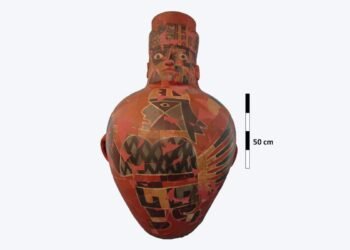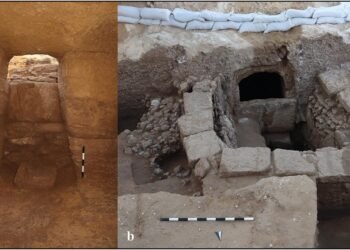Archaeologists in Mazovia, Poland, have unearthed a bronze Celtic helmet from the 4th century BCE, along with approximately 300 other artifacts, at the ancient settlement of Łysa Góra.
This find, led by a team from the State Archaeological Museum in partnership with the University of Warsaw, has global significance, as it challenges long-held assumptions about the extent of Celtic presence in Poland.
The excavation, conducted over five weeks, revealed a range of Iron Age objects, including iron axes, spearheads, sickles, and a sword, many of which are linked to Celtic craftsmanship. According to Dr. Bartłomiej Kaczyński, who headed the research, the discovery of the helmet is particularly noteworthy. “This is a rare artifact and an example of advanced Celtic metallurgy,” Kaczyński told Nauka w Polsce, a Polish science news outlet. The La Tène-style helmet, which emerged in European Iron Age culture around 450 BCE, is the first of its kind to be discovered in Poland, and only a few such examples exist worldwide.
Initially mistaken for a bronze vessel, the helmet’s identity was confirmed when researchers, including Dr. Andrzej Maciałowicz from the University of Warsaw, uncovered distinctive features such as a neck guard and the calotte—the top part of the helmet with a double knob. These elements aligned with known La Tène Celtic helmet designs, confirming its rare and significant nature. “When we uncovered the shape of the calotte, we no longer had any doubts that we had a very rare artifact,” Kaczyński explained.
Wojciech Borkowski, the deputy director of the State Archaeological Museum in Warsaw, called it “the first helmet of its kind found in Poland, and the oldest ancient helmet ever uncovered in the country,” in a statement to RMF24, a Polish broadcaster. The discovery has led researchers to reassess the spread of Celtic influence, which was previously thought to be confined to southern Poland. The presence of Celtic artifacts in the north of Mazovia suggests that Celtic culture and trade networks extended further than previously believed.
Excavations at Łysa Góra have revealed much more than just the helmet. Evidence of a defensive settlement spanning roughly three hectares has also been found, with burn marks suggesting possible conflicts between the Celts and other groups, such as the Vandals. Researchers have also uncovered iron tools and bronze ornaments that offer clues about the site’s importance as a trading hub. The variety of objects points to the site’s role in broader European trade networks during the early Iron Age, particularly in the amber trade, a valuable commodity at the time.
The helmet, though in poor condition, has been sent to the Conservation Department of the State Archaeological Museum for restoration, a process expected to take several months. Mikołaj Organek, a conservator specializing in ancient metal artifacts, has been entrusted with the delicate task of preserving this remarkable piece of history.
Beyond the helmet, the discovery of farming and woodworking tools at the site illustrates the daily life of the settlement’s inhabitants, many of whom practiced agriculture and animal husbandry. Kaczyński noted the presence of axes, sickles, and even a blade that may have been used for shearing sheep wool. Additionally, rare artifacts from the West Baltic Kurgan culture, including multi-coiled armlets worn by women, were also found.
The site at Łysa Góra has been of archaeological interest since its discovery in 1959. Previous excavations have revealed semi-dugout buildings, hearths, and evidence of ironworking. This season’s discoveries, however, have exceeded expectations and opened new avenues of research. “The abundance of discoveries shows that we have more work ahead of us than we initially thought,” Kaczyński remarked, adding that further analysis will also focus on items excavated in the 1970s and 1980s, which remain unexamined.






















